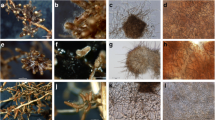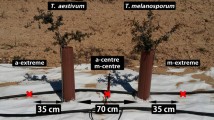Abstract
Despite recent findings, truffles are rarely found in Finland. In 2006, we began to explore the cultivation potential of Tuber aestivum/uncinatum in Finland. In 2006–2008, roughly 1,200 Quercus robur seedlings and 200 Q. pubescens seedlings were planted in 20 orchards. We aimed to challenge the Southern European (France) tree provenances of oak seedlings in a boreal climate. Additional winter coverings made up of fabric or plastic and twigs prevented the seedlings’ mortality even when the air temperature was below −30 °C during the second winter. The results showed that the top soil temperature at 15 cm depth has to be above −5 °C to guarantee the survival of seedlings. Q. pubescens was more sensitive to low soil temperatures than Q. robur. Morphological and PCR analysis of root samples collected over 2007–2010 confirmed the presence of T. aestivum in all orchards despite unfavorable temperatures during the winter time. The first T. aestivum sporocarps were found under Q. robur in October 2012 in the orchards established in 2006 on old agricultural land, showing truffle cultivation to be successful in the boreal climate.



Similar content being viewed by others
References
Agerer R (1987–2008) Colour Atlas of Ectomycorrhizae, 13th edn. Einhorn, Munich
Agerer R, Rambold G (2004–2012) [first posted on 2004-06-01; most recent update: 2011-01-10]. DEEMY — an information system for characterization and determination of ectomycorrhizae. www.deemy.de – München, Germany
Bencivenga M, Granetti B (1988) Flora, vegetazione e natura dei terreni di alcuni tartufaie naturali di Tuber magnatim Pico dell’Italia Centrale. In: Bencivenga M, Granetti B (eds) Atti del secondo congresso internazionale sul tartufo, Spoleto, 24–27 novembre 1988. Dip. de Biologia Vegetale, Universita deegli studi di Perugia, Perugia, Italy
Benucci GMN, Raggi L, Albertini E, Grebenc T, Bencivenga M, Falcinelli M, Di Massimo G (2011) Ectomycorrhizal communities in a productive Tuber aestivum orchard: composition, host influence and species replacement. FEMS Microbiol Ecol 76:170–184. doi:10.1111/j.1574-6941.2010.01039.x
Bruhn JN, Mihail JD, Pruett GE (2013) Truffle seedling production method has long-term consequences for tree growth and root colonization. Agrofor Syst 87:679–688
Chevalier G (2012) Europe, a continent with high potential for the cultivation of the Burgundy truffle (Tuber aestivum/uncinatum). Acta Mycol 47:127–132
Chevalier G, Frochot H (2002) La Truffe de Bourgogne (Tuber uncinatum Chatin). Editions Petrarque, Levallois-Perret Cedex
Chevalier G, Grente J (1978) Application pratique de la symbiose ectomycorhizienne: production a grande échelle de plantes mycorhizees par la truffe (Tuber melanosporum Vitt.). Mushroom Sci 10:483–505
Chevalier G, Sourzat P (2012) Soils and techniques for cultivating Tuber melanosporum and Tuber aestivum in Europe. In: Zambonelli A, Bonito GM (eds) Edible ectomycorrhizal mushrooms, soil biology, vol 34. Springer, Germany
Gardin L (2005) I tartufi minori in Toscana. Gli ambienti di crescita dei tartufi marzuolo e scorzone. ARSIA, Toscana
Grebenc T, Piltaver A, Kraigher H (2000) Establishment of PCR-RFLP library for basidiomycetes, ascomycetes and their ectomycorrhizae in Picea abies (L.) Karst. Phyton 40:79–82
Hall I, Brown GT, Zambonelli A (2007) Taming the Truffle: the history, lore, and science of the ultimate mushroom. Timber, Oregon
Hall IR, Zambonelli A, Primavera F (1998) Ectomycorrhizal fungi with edible fruiting bodies. 3. Tuber magnatum, Tuberaceae. Econ Bot 52:192–200
Hall I, Yun W (2001) Truffles and other edible mycorrhizal mushrooms - some new crops for the Southern Hemisphere. In: Proceedings of the Second International Conference on Edible Mycorrhizal Mushrooms. New Zealand Institute for Crop and Food Research Limited, Christchurch, New Zealand, pp 1–7
Hall IR, Yun W, Amicucci A (2003) Cultivation of edible ectomycorrhizal mushrooms. Trends Biotechnol 21:433–438
Hasselquist NJ, Germino MJ, McGonigle T, Smith WK (2005) Variability of Cenococcum colonization and its ecophysiological significance for young conifers at alpine treeline. New Phytol 165:867–873
Jeandroz S, Murat C, Wang Y, Bonfante P, Le Tacon F (2008) Molecular phylogeny and historical biogeography of the genus Tuber, the “true truffles”. J Biogeogr 35:815–829
Kershaw S (1993) The Silurian geology of Gotland, Sweden. Geol Today 9:187–190
Koponen S (2004) Arthropodes from high oak branches — comparison of two trap types. Latv Ent 41:71–75
Kraigher H, Agerer R, Javornik B (1995) Ectomycorrhiza of Lactarius lignyotus on Norway spruce, characterised by anatomical and molecular tools. Mycorrhiza 5:175–180
Lefevre CK, Hall IR, Mehlenbacher SA (2001) Status of truffle cultivation: a global perspective. Acta Hortic 556:513–520
Mello A, Murat C, Bonfante P (2006) Truffles:muchmore than a prized and local fungal delicacy. FEMS Microbiol Lett 260:1–8
Nenonen J, Portaankorva A (2009) The geology of the lakeland Finland area. Geological Survey of Finland – Northern Periphery Program
Orczán KÁ, Turunen O, Merényi Z, Rudnóy S, Bratek Z, Shamekh S (2010) Tuber foetidum found in Finland. Mycotaxon 114:127–133
Paolocci F, Rubini A, Riccioni C, Topini F, Arcioni S (2004) Tuber aestivum and Tuber uncinatum: two morphotypes or two species? FEMS Microbiol Lett 235:109–115
Peterson RL, Bonfante P (1994) Comparative structure of vesicular arbuscular mycorrhizas and ectomycorrhizas. Plant Soil 159:79–88
Pruett G, Bruhn J, Mihail J (2008) Temporal dynamics of ectomycorrhizal community composition on root systems of oak seedlings infected with Burgundy truffle. Mycol Res 112:1344–1354
Riousset L, Riousset G, Chevalier G, Bardet M-C (2001) Truffes d’Europe et de Chine. INRA, Paris
Shamekh S, Donnini D, Zambonelli A, Leisola M (2009) Wild Finnish truffles. Acta Bot Yunnan 31(S16):69–71
Sourzat P (2000) Trufficulture — Résultats techniques d’expérimentations a l’usage pratique des trufficulteurs. Lycée professional agricole et viticole de Cahors-Le Montat, Le Montat
Streiblová E, Gryndlerová H, Valda S, Gryndler M (2010) Tuber aestivum – hypogeous fungus neglected in the Czech Republic. Czech Mycol 61:163–173
Stobbe U, Buntgen U, Sproll L, Tegel W, Egli S, Fink S (2012) Spatial distribution and ecological variation of re-discovered German truffle habitats. Fungal Ecol 5:591–599
Suz LM, Martin MP, Colinas C (2006) Detection of Tuber melanosporum DNA in soil. FEMS Microbiol Lett 254:251–257
Thomas PW (2012) The role of pH in Tuber aestivum syn. uncinatum mycorrhiza development within commercial orchards. Acta Mycol 47:161–167
Tveito OE, Førland E, Heino R, Hanssen-Bauer I, Alexandersson H, Dahlström B, Drebs A, Kern-Hansen C, Jónsson T, Vaarby Laursen E, Westman Y (2000) Nordic temperature maps. DNMI-Report, Norwegian Meteorological Institute, Report no. 09/00
Unterseher M, Westphal B, Amelang N, Jansen F (2012) 3,000 species and no end — species richness and community pattern of woodland macrofungi in Mecklenburg-Western Pomerania, Germany. Mycol Prog 11:543–554
Wedén C, Chevalier G, Danell E (2004a) Tuber aestivum (syn. T. uncinatum) biotopes and their history on Gotland, Sweden. Mycol Res 108:304–310
Wedén K, Danell E, Camacho FJ, Backlund A (2004b) The population of the hypogeous fungus Tuber aestivum syn. T. uncinatum on the island of Gotland. Mycorrhiza 14:19–23
Wedén C, Danell E, Tibell L (2005) Species recognition in the truffle genus Tuber - the synonyms Tuber aestivum and Tuber uncinatum. Environ Microbiol 7:1535–1546
Wedén C, Pettersson L, Danell E (2009) Truffle cultivation in Sweden: results from Quercus robur and Corylus avellana field trials on the island of Gotland. Scand J For Res 24:37–53
White TJ, Bruns T, Lee S, Taylor J (1990) Amplification and direct sequencing of fungal ribosomal RNA genes for phylogenetics. In: Innis MA, Gelfand DH, Sninsky JJ, White TJ (eds) PCR Protocols. A guide to methods and applications. Academic, San Diego, pp 315–322
Zambonelli A, Iotti M, Zinoni F, Dallavalle E, Hall IR (2005) Effect of mulching on Tuber uncinatum ectomycorrhizas in an experimental truffière. NZ J Crop Hortic 33(1):65–73
Acknowledgments
We would like to thank Rajupusu Leader ry and the Regional Council of South Savo for financial support, as well as the orchard owners for their kind cooperation. Thanks also to Mrs Heli Valtonen for her assistance. The partner from the Slovenian Forestry Institute was co-financed by the Ministry of Higher Education, Science and Technology through Research Programme P4-0107 and the Targeted Research Program Project CRP V4-0492.
Author information
Authors and Affiliations
Corresponding author
Rights and permissions
About this article
Cite this article
Shamekh, S., Grebenc, T., Leisola, M. et al. The cultivation of oak seedlings inoculated with Tuber aestivum Vittad. in the boreal region of Finland. Mycol Progress 13, 373–380 (2014). https://doi.org/10.1007/s11557-013-0923-5
Received:
Revised:
Accepted:
Published:
Issue Date:
DOI: https://doi.org/10.1007/s11557-013-0923-5




